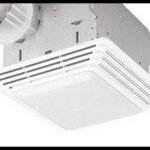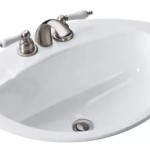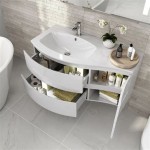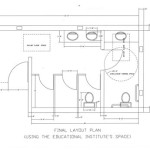Bathroom Sink Materials: A Comprehensive Look at Pros and Cons
Choosing the right bathroom sink involves careful consideration of various factors, including aesthetics, budget, durability, and maintenance. A significant aspect of this decision lies in selecting the appropriate material for the sink itself. Different materials offer distinct advantages and disadvantages, impacting the overall look, feel, and longevity of the bathroom.
This article provides a detailed overview of common bathroom sink materials, outlining the pros and cons of each to aid in making an informed decision. The information presented focuses on materials frequently encountered in residential bathroom design and aims to equip the reader with knowledge to navigate the selection process effectively.
Porcelain: A Classic and Affordable Option
Porcelain, a type of ceramic, is a widely used material for bathroom sinks. Its popularity stems from its affordability, durability, and ease of maintenance. Porcelain sinks are typically made by firing clay at high temperatures, resulting in a smooth, non-porous surface.
Pros:
Affordability is a major advantage of porcelain. It is generally one of the least expensive sink materials available, making it an attractive option for budget-conscious homeowners or large-scale renovations. The lower cost does not necessarily equate to inferior quality, as porcelain can offer excellent performance for its price point.
Cleaning and maintenance are relatively straightforward. The smooth, non-porous surface resists staining and bacterial growth. Regular cleaning with mild soap and water is usually sufficient to keep a porcelain sink looking its best. Abrasive cleaners should be avoided as they can scratch the surface over time.
Durability, when properly cared for, is also a benefit. Porcelain is resistant to heat and most common household chemicals. While it can chip or crack under significant impact, it is generally a robust material for everyday use. The color is baked into the material, so it won't fade over time.
Availability in a wide range of styles and colors makes porcelain versatile for various bathroom designs. Whether looking for a traditional pedestal sink or a modern vessel sink, porcelain options are plentiful. This allows for seamless integration with existing fixtures and décor.
Cons:
Chipping and cracking are potential drawbacks. While durable, porcelain is susceptible to damage from sharp impacts. Heavy objects dropped into the sink can cause chips, and significant force can lead to cracks. Repairs can be difficult and may require professional assistance. Chips can sometimes expose the base material which can be porous and lead to staining.
Limited design flexibility compared to some other materials exists. While available in various styles, porcelain sinks are typically produced using molds, restricting the complexity of design features. This can be a limiting factor for those seeking highly customized or unique sink shapes.
Can feel cold to the touch, especially in colder climates. This can be a minor inconvenience for some users, particularly during winter months. While not a significant drawback, it is a factor to consider for overall comfort.
Stone: Natural Beauty and Luxury
Stone sinks, including granite, marble, and travertine, offer a natural and luxurious aesthetic to bathrooms. These sinks are carved from solid blocks of stone, providing a unique and visually appealing element.
Pros:
Unique aesthetic due to natural variations in the stone. Each stone sink is one-of-a-kind, featuring unique patterns, veining, and color variations. This natural beauty adds a touch of elegance and sophistication to any bathroom.
Durability and longevity are inherent to many types of stone. Granite, for example, is extremely durable and resistant to scratches, heat, and stains. Marble, while softer, can still provide excellent longevity with proper sealing and care. Stone sinks are generally heavy and solid, contributing to their long lifespan.
Adds significant value to the home due to its high-end appeal. Installing a stone sink can enhance the perceived value of the bathroom and the overall property. This makes it an attractive investment for homeowners looking to upgrade their bathrooms.
Cons:
High cost compared to other materials is a significant disadvantage. Stone sinks are among the most expensive options available, reflecting the material cost, fabrication process, and installation requirements. This can be a barrier for budget-conscious homeowners.
Requires regular sealing to prevent staining and water damage. Stone is naturally porous, making it susceptible to staining and water absorption. Regular sealing, typically every 6-12 months, is necessary to maintain the sink's appearance and prevent damage. This adds to the ongoing maintenance requirements.
Can be difficult to clean due to the porous nature of the material. While sealing helps, stone can still be prone to soap scum and mineral buildup. Specialized cleaners designed for stone are often required to avoid damaging the surface. Harsh chemicals should be avoided.
Heavy and difficult to install, potentially requiring professional assistance. The weight of stone sinks makes them challenging to handle and install. Proper support structures may be required to accommodate the weight, and professional installation is often recommended.
Solid Surface: A Versatile and Seamless Option
Solid surface materials, such as Corian or Swanstone, are man-made materials composed of acrylic or polyester resins and mineral fillers. These materials offer a seamless and non-porous surface, making them a popular choice for modern bathrooms.
Pros:
Seamless design allows for integrated sinks and countertops. Solid surface materials can be molded into various shapes and sizes, allowing for the creation of seamless sinks and countertops. This eliminates crevices and grout lines, making cleaning easier and preventing the growth of mold and mildew.
Non-porous surface resists staining and bacterial growth. The non-porous nature of solid surface materials makes them resistant to staining, water damage, and bacterial growth. This contributes to a hygienic and low-maintenance bathroom environment.
Repairable scratches and minor damage can often be sanded out. Solid surface materials are relatively easy to repair. Minor scratches and stains can often be sanded out, restoring the sink's original appearance. This extends the lifespan of the sink and reduces the need for replacement.
Wide range of colors and patterns available, offering design flexibility. Solid surface materials are available in a wide array of colors, patterns, and textures, allowing for greater design flexibility. This enables homeowners to create custom looks that complement their bathroom décor.
Cons:
Can be susceptible to heat damage, particularly from hot curling irons or pots. While generally durable, solid surface materials can be damaged by excessive heat. Hot objects should be placed on a trivet or heat-resistant pad to avoid discoloration or warping.
Can be scratched by abrasive cleaners or sharp objects. While scratches can be repaired, it is important to avoid using abrasive cleaners or exposing the surface to sharp objects. Gentle cleaning methods and protective measures can help prevent scratches.
May not have the same natural beauty as stone materials. Although available in various colors and patterns, solid surface materials lack the natural veining and unique characteristics of stone. This can be a drawback for those seeking a truly natural aesthetic.
Glass: A Modern and Stylish Choice
Glass sinks, often made of tempered glass, offer a modern and stylish aesthetic to bathrooms. They come in a variety of shapes, sizes, and colors, adding a touch of elegance and sophistication.
Pros:
Unique and modern aesthetic that can enhance the overall design of the bathroom. Glass sinks provide a visually striking element to the bathroom, adding a touch of contemporary elegance. Their unique shapes and colors can create a focal point and enhance the overall design.
Non-porous and resistant to staining, similar to porcelain. Tempered glass is non-porous, making it resistant to staining and water damage. This contributes to a hygienic and easy-to-maintain surface. Spills and splashes can be easily wiped away.
Easy to clean with mild soap and water. Cleaning glass sinks is relatively simple. Mild soap and water are usually sufficient to remove dirt and grime. Avoid using abrasive cleaners, which can scratch the surface.
Cons:
Susceptible to scratches and chipping, requiring careful handling. While tempered glass is durable, it is still susceptible to scratches and chipping. Care should be taken to avoid dropping heavy objects into the sink or using abrasive cleaners.
Water spots and fingerprints can be visible, requiring frequent cleaning to maintain a pristine appearance. Glass surfaces tend to show water spots and fingerprints easily, requiring frequent cleaning to maintain a clean and polished appearance. This can be a drawback for those seeking a low-maintenance option.
Can be more expensive than some other materials, such as porcelain. Glass sinks are often more expensive than porcelain sinks, reflecting the specialized manufacturing process and the aesthetic appeal of the material. This can be a factor for budget-conscious homeowners.
Stainless Steel: A Durable and Hygienic Option
Stainless steel sinks, known for their durability and hygienic properties, are frequently found in commercial settings but are also gaining popularity in residential bathrooms.
Pros:
Highly durable and resistant to rust, corrosion, and staining. Stainless steel is exceptionally durable and resistant to rust, corrosion, and staining. This makes it a long-lasting and reliable choice for bathroom sinks. It can withstand daily use and is unlikely to be damaged by water or chemicals.
Hygienic and easy to clean, making it a good choice for high-traffic bathrooms. Stainless steel's non-porous surface makes it hygienic and easy to clean. It resists bacterial growth and is easy to disinfect, making it a good choice for high-traffic bathrooms or homes with young children.
Modern and industrial aesthetic that can complement contemporary bathroom designs. Stainless steel sinks offer a modern and industrial aesthetic that complements contemporary bathroom designs. Their sleek and minimalist appearance can add a touch of sophistication to the bathroom.
Cons:
Can be noisy, particularly when water is running. Stainless steel sinks can be noisy, especially when water is running or objects are dropped into the sink. This can be mitigated by choosing a sink with sound-dampening features.
Susceptible to water spots and fingerprints, requiring frequent cleaning. Similar to glass, stainless steel sinks can show water spots and fingerprints easily, requiring frequent cleaning to maintain a polished appearance. This can be a drawback for those seeking a low-maintenance option.
Can be scratched by abrasive cleaners or sharp objects. While durable, stainless steel can be scratched by abrasive cleaners or sharp objects. Gentle cleaning methods and protective measures can help prevent scratches.

The Most Common Sinks Materials Pros And Cons Before You Purchase In 2024 Badeloft

The Most Common Sinks Materials Pros And Cons Before You Purchase In 2024 Badeloft

Bathroom Vessel Sink Materials Pros And Cons Guilin Cabinets

Fireclay Vs Cast Iron Sink Pros Cons And How To Choose Van Dyke S Rers

Best Types Of Bathroom Countertops Modernize
Bathroom Sink Material Guide Signature Hardware

The Most Common Sinks Materials Pros And Cons Before You Purchase In 2024 Badeloft

The Most Common Sinks Materials Pros And Cons Before You Purchase In 2024 Badeloft

The Pros And Cons Of Above Counter Basins Abi Interiors
Bathroom Sink Material Guide Signature Hardware







